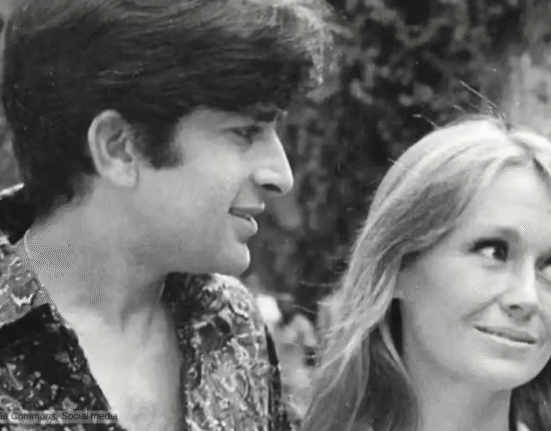C. Ramchandra, a creative genius, initially pursued acting in the city of dreams but transitioned into a celebrated music director. His “Aye Mere Watan Ke Logon, Zara Aankh Mein Bhar Lo Paani” is nothing less than another national anthem for the nation.
His genius marked him as a pioneer, introducing diverse and trendsetting music. Hhe composed everything from lively club tunes to soothing lullabies and soulful ghazals. C. Ramchandra transformed Hindi film music by infusing Western influences during an era dominated by mellow tunes. His timeless and upbeat tracks, such as “Aana Meri Jaan Meri Jaan” and Sunday Ke Sunday,” were nothing short of a rebellion in those times. He continued to make the silly, juvenile songs influenced by western music, which can still force a smile on listeners faces.
Early Life of C. Ramchandra
C. Ramchandra was born as Ramachandra Narhar Chitalkar in Puntambe village (Ahmednagar), on January 12, 1918. As a child, his ambition was to become a soldier or a musician. He learnt classical music for six years under Sri Shankerrao Sapre.
A handsome man with 6 feet of height and a spate of curly hair bagged the lead role in the Hindi film Naganand (1935), which was a huge flop. The failure of his subsequent films Said-e-Hawas (1936) and Atma Tarang (1937) forced him to leave acting, and his focus shifted toward music.
Chitalkar The Singer

He used various pseudonyms like Anna Sahib (in the movies Bahadur Pratap, Matwale, and Madadgaar), Ram Chitalkar (in the movies Sukhi Jeevan, Badla, Mr. Jhatpat, Bahadur, and Dosti), P Ramakant, Shyamoo (in the movie Yeh hai duniya), and finally C Ramachandra.
For his career as an occasional playback singer, he used only his surname, Chitalkar, and sang some renowned and unforgettable duets with Lata Mangeshkar, such as “Kitna Haseen Hai Mausam” in the film Azaad (1955) and “Shola Jo Bhadke” in Albela (1951). He gave playback for the great trinity Raj Kapoor (Sargam), Dilip Kumar (Azaad), and Dev Anand (Barish), displaying his prowess as a playback singer. He also sang in films like Jhamela, Sargam, Nadiya Ke Paar, Khazana, Sagai, Sanwariya, Shin Shinaki Boobla Boo, Sharda, Shagufta, etc.
The Music Director with a difference
C. Ramchandra debuted as a full-fledged music director in the Tamil film ‘Jayakkodi.’ He soon found success through films like “Sukhi Jeevan, 1942,” “Safar, 1946,” “Leela, 1947. “Shehnai,” in 1947, included ‘Mar katari marjana’ and ‘Meri Jaan, Sunday Ke Sunday.” He achieved tremendous success with Patanga (1949). It has nuggets like ‘Dil Se Bhula Do..’; ‘Jane Wale Tune..’ and the evergreen duet ‘Mere Piya Gaye Rangoon.’.
Samadhi (1950) had the dance number ‘Gore Gore, O Baanke Chhorey, which became a cult and chartbuster song. It was a direct lift from Edmundo Ros’s Chico-Chico. He created nostalgic music of Albela (1951), displaying his wide range from the deeply soulful ‘Dhreere Se Aa Ja..’ to the peppy ‘Shola Jo Bhadke..’ to a qawwali-style song ‘Haseeno Se Mohabbat.’.
His biggest success came with Anarkali (1953), and all its songs, especially ‘Yeh Zindagi Usiki Hai..,’ ‘Mujhse Mat Poochh..,’ ‘Mohabbat Aisi Dhadkan Hai..,’ and ‘Jaag Dard-e-Ishq Jaag..,’ were acclaimed as masterpieces. In 1955, for “Azaad,” he made ‘Aplam Chaplam..’, ‘Na Bole Na Bole..’, and ‘Kitna Haseen Mausam.’ He gave the dreamy ‘Aankhon mein sama jaao, iss dil mein raha karna’ in “Yasmin.” The film starring Suresh and Vyjayanthimala came in 1955.
He replaced V. Shgantaram’s long-time collaborator Vasant Desai, in Navrang (1956). He made timeless rag-based tunes like “Aadha hai chandrama,” “Shyamal Shyamal Baran,” and “Tu chhupi hai kahan.”


C. Ramchandra The Innovator
C. Ramchandra brought the vibrant beats of rock ‘n’ roll to India before it swept through Europe. In “Meri Jaan..Sunday Ke Sunday…” (Shehnai), he infused the Benny Goodman style of jazz clarinet, blending Western instruments with traditional Indian ones. The result was mesmerizing, especially in energetic tunes like “Shola Jo Bhadke…” and “Ye Diwana Ye Parwana…”. A maestro in innovation, he crafted “Eena Meena Deeka” (Asha) with scat singing, a playful collaboration with his assistant John Gomes, showcasing his dynamic approach to music.
Later Career
C. Ramachandra ventured into film production with “New Sai Productions,” a collaboration with comedian Om Prakash. The banner witnessed the creation of three Hindi films – Jhanjhar, Lehren, and Duniya Gol Hai. Additionally, he produced two Marathi movies, Dhananjay and Gharkul. Passionate about music, he also established an Academy of Indian Music.
In 1977, he penned his autobiography, ‘Mere Jeevan Ki Sargam,’ The Symphony of My Life (माझ्या जीवनाची सरगम in Marathi) in Marathi.
His final contribution to Hindi cinema was ‘Rootha Na Karo’ in 1970. Over his prolific career, he composed music for 112 films in Hindi, Marathi, Telugu, Tamil, and Bhojpuri. C. Ramachandra passed away on January 5, 1982.
C. Ramchandra on IMBD









